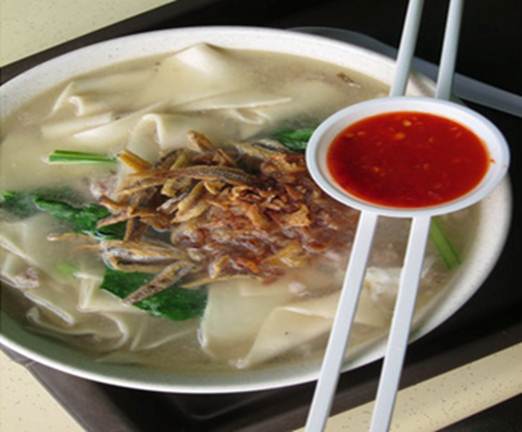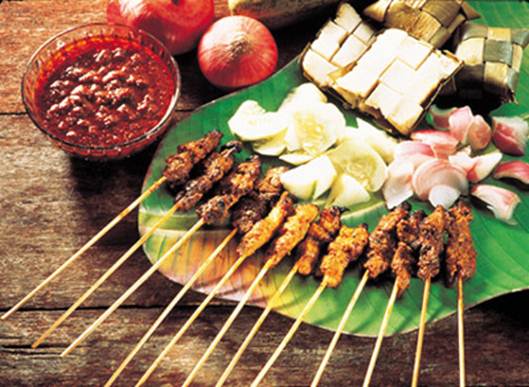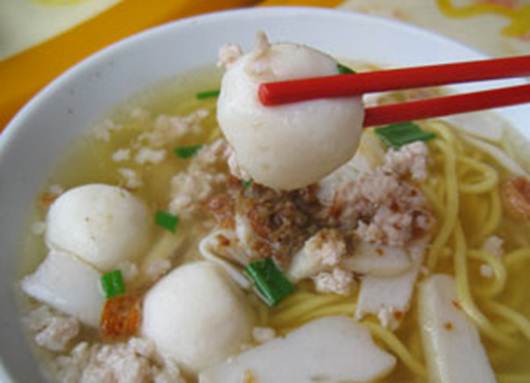Tuck into…
Japanese – style teriyaki fish set

Japanese
– style teriyaki fish set
This much-loved meal – served with either
rice or noodles – consists of deep – sea fatty fish like salmon or sardines.
These are rich sources of omega-3 fatty acids, which help in baby’s brain and
eye development, says Jenette.
Tip: Worried about toxic rationing albacore
(“white”) tuna to 170g or less per week, as this variety contains more mercury
than canned light tuna. “Alternatively, you can also get your omega-3 fatty
acids from soya beans and eggs fortified with omega-3 fatty acids,” she says.
Ban mian

Served
with meat, egg, veggies and ikan bilis, this soupy noodle dish is one of the
more balanced street food options for expectant mums.
Served with meat, egg, veggies and ikan
bilis, this soupy noodle dish is one of the more balanced street food options
for expectant mums. “Compared to other hawker food, ban mian is lower in fat,
high in protein and comes with fibre from vegetables,” says Agnes. To be safe,
make sure the egg is thoroughly cooked, she adds. In general, dishes that are
cooked only after you place your order are a safer option when dining at hawker
centers, adds Nehal.
Tip: Ask for extra helping of veggies. The
additional fibre will ease constipation, a common and annoying pregnancy
problem.
Sliced fish soup

“Fish
is an excellent source of high-quality protein, as well as other nutrients like
vitamin D and iodine.”
According to the experts, this is one of
the healthier hawker choices.
“Fish is an excellent source of
high-quality protein, as well as other nutrients like vitamin D and iodine,”
says Jenette. However, the US FDA recommends that pregnant women avoid large
fish like shark, swordfish and ikan batang.
But don’t most hawkers use ikan batang for
sliced fish soup? “According to the Agri-food and Veterinary Authority of
Singapore is monitored, so the ikan batang used shouldn’t contain high levels,”
shares Jenette. However, she recommends limiting this food choice to twice
week.
Tip: Don’t just drink the soup, says
Jenette. “Be sure to eat the fish, too!: The nutrients are in both the soup and
ingredients.
Mixed rice

Mixed
rice
To achieve a balanced meal with this dish
that’s usually eaten with rice or porridge, Nehal advises including a serving
each of protein (lean meat, fish, chicken or beans) and vegetables.
Tip: Make sure to vary your choice of
veggies every day, as different colored ones give you different types of
vitamins, minerals and antioxidants, says Nehal. If the stall offers brown
rice, opt for that. The wholegrain version gives you added fibre, which keep
you full longer and benefits your heart. To enhance iron absorption, end your
meal with a slice of fruit, advises Nehal.
Indulge occasionally…
Satay

Satay
This meaty dish may be high in protein,
iron, niacin and vitamin B6, but be careful where you eat it. Avoid roadside
hawker stalls or warungs (when overseas). These places may have poor hygiene
levels and the food is often cooked out in the open or exposed to dust and
flies, says Agnes. Avoid eating the raw vegetables such as onions and cucumber
that are typically served with satay.
Tip: To decide which stalls to purchase
from, Agnes advises checking the standard of hygiene before ordering preparing
your own grilled chicken (skinless) or other lean cuts at home. This way, you
get to enjoy it and its higher nutritional values, and lower your risk of
infection, says Agnes.
Fishball noodles

Fishball
noodles
While this one-dish hawker fare is
relatively low in calories (one bowl contains about 370), Siew Choo says it’s
generally low in fibre, protein (sorry, the fish balls don’t really count),
vitamins and minerals. But you can certainly make it healthier by choosing the
soupy version and getting the stall uncle tp top up some ingredients.
Tip: By choosing the soupy version, you
would cut down on added salt and other preservatives from the chilli and tomato
sauces. Get the uncle to add extra lettuce and bean sprouts (and lean meat, if
available).
Some stalls also include liver in the dish.
Nehal advises going easy on this ingredient. “Limit intake to two tablespoons
per week in the first trimester, as it’s rich in vitamin A. Too much of this
vitamin can cause birth defect in babies,” she explains.